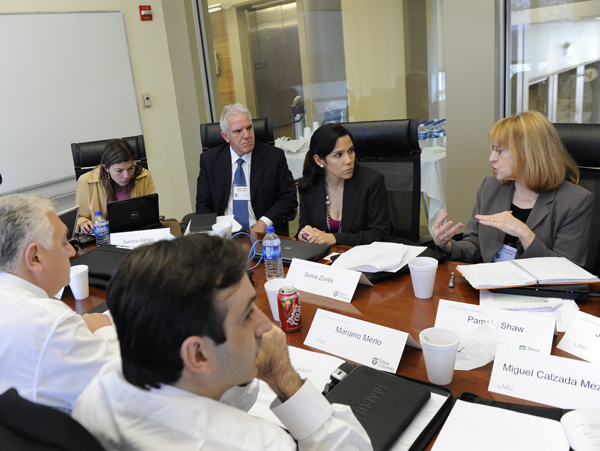
Representatives from Burkenroad Reports for Latin America’s nine partner universities meet at the Freeman School each year.
By Eduardo Pablo, professor of practice and coordinator of Burkenroad Reports for Latin America
It probably wouldn’t surprise many investors to learn that the average annualized total return of the MSCI Emerging Markets China Index for the 10-year period ending Dec. 31, 2012, was a robust 19.26 percent. What might surprise a few people is to learn what the total return of the MSCI Emerging Markets Latin America Index was over that same period: It was 22.72 percent.
For most U.S. investors, Latin America tends to fly under the radar, but here at the A. B. Freeman School of Business, we’ve been paying close attention to Latin American equity markets for more than a decade. In September 2001, the Freeman School launched Burkenroad Reports for Latin America, an equities analysis program focused exclusively on companies in Latin America. The program was established with partial funding from the Inter-American Development Bank, which hoped to improve the efficiency of capital markets in Latin America. From the perspective of the Freeman School, the goal was the same as its namesake program in New Orleans: To provide investors with objective information on public companies while providing students with real-world financial analysis skills.
Burkenroad Reports for Latin America initially featured just a handful of student analysts covering a small number of companies in Mexico, Colombia and Venezuela. Today, the program has grown into a partnership between the Freeman School and nine of Latin America’s top business schools. Each year, more than 100 student analysts research, write and publish reports on more than 25 companies in Argentina, Chile, Colombia, Ecuador, Guatemala, Mexico, Panama, Peru and Venezuela.
Equities research in Latin America can be a challenge. In most of the countries, the top management of publicly listed companies are usually the owners of the firm, and they’re generally averse to meeting with analysts to talk about the company and its prospects. They hold their privacy dear, and they do not want to be recognized publicly as the owner of a successful firm. When the company submits ownership-related information to the regulatory bodies, the owner is typically listed as Corporation XYZ. This isn’t just for the sake of privacy. In Colombia and Venezuela, managers who reveal personal information face a very real risk of being kidnapped, and in Venezuela, managers believe that by lowering the amount of public information about themselves and their companies, they can reduce the likelihood of their companies being expropriated. Throughout Latin America, the information that public companies must disclose to market participants is significantly less than in the United States, and to make matters worse, some countries require public companies to report financial information just once a year. This is counterintuitive in a region that suffers from such a high level of volatility.
Despite these difficulties, market participants in the region are beginning to recognize the value of Burkenroad Reports for Latin America. Just after going public in June 2008, the Mexican Stock Exchange contacted ITESM, Freeman’s partner institution in Monterrey, Mexico, to prepare an independent report on the exchange. In addition, students who have taken the Burkenroad Reports course have been hired— sometimes before graduation—as financial analysts at regional investment banks and universal banks. Some have even been hired by the companies they were covering. Today, more than 10 years since its inception, I have no doubt that the Burkenroad Latin America program has delivered on its objective to improve the informational efficiency of markets in the region while offering students highly sought after financial analysis skills.
This improved informational efficiency comes at a particularly good time for investors. Most countries in Latin America are better prepared to weather uncertain economic times than developed countries. For example, the average debt-to-GDP ratio across Latin America is around 50 percent compared to the U.S. debt-to-GDP ratio of 73 percent. In 2011, Mexico was able to issue a sovereign bond in U.S. dollars with a 100-year maturity paying just 242 basis points above 30-year U.S. Treasury bonds. And most of the Latin American currencies are stronger than the U.S. dollar and will retain their long-term value even in worst-case scenarios. Given these factors, I expect to see a high percentage of “buy” recommendations in 2013 for Burkenroad Reports for Latin America. For investors who embrace the Burkenroad philosophy




{ 0 comments… add one now }